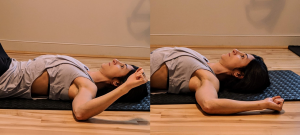The execution of a strict bodyweight pull-up is the paragon of upper body strength and should be a goal for every fitness client and enthusiast. Many people get stalled out on a weight assistance pull-up machine while others force the movement with poor form and execution, setting themselves up for injury or the inability to progress. Still others get hooked on the pull-up’s little cousin, a chin-up, which is also a great exercise for upper body strength, but slightly easier to execute given the stronger bicep recruitment.
Shoulder Mobility Assessments

Arm lying flat on floor is adequate external rotation.
The first step before moving forward with attempting bodyweight pull-ups is to do movement assessments in order to determine if any mobility restrictions will hinder the process. The three areas that need to be observed and assessed are lat length and thoracic mobility, scapulae rotation restrictions, and degree of internal versus external rotation at the glenohumeral joint.
Corrective Exercise to Improve Shoulder Joint Mobility
 Once the trainer has determined which, if any (and spoiler: pretty much everyone will have some issue in one of these areas), he or she can move forward with correcting the imbalance. There are specific movements one can do to improve mobility of the thoracic spine and lengthen the lats such as thoracic mobilizations over a foam roller.
Once the trainer has determined which, if any (and spoiler: pretty much everyone will have some issue in one of these areas), he or she can move forward with correcting the imbalance. There are specific movements one can do to improve mobility of the thoracic spine and lengthen the lats such as thoracic mobilizations over a foam roller.
Understanding scapular upward and downward rotation is tricky, but getting a good handle on it is a valuable tool for every fitness professional. Improving the performance of the scapular upward and downward rotators like the lower trapezius without involving the pec minor require specific cueing.
Finally, since most people have to improve limited external rotation in the shoulder joint, and instead, tend to be more internally rotated, steps can be taken to lengthen muscles like the teres major and pecs and strengthen the infraspinatus and teres minor.
Pull-up Regressions
 Once you’ve got that mobility all straightened out, you can begin to program exercises that both build strength and endurance at the right tempo and inspire confidence in the client.
Once you’ve got that mobility all straightened out, you can begin to program exercises that both build strength and endurance at the right tempo and inspire confidence in the client.
Starting with grip strength and working up through progressive strengthening exercises like isometric holds, negatives and assisted pull-ups will set up your client for learning how to do a strict pull-up.
There are few exercises more empowering and satisfying than pull-ups. Naturally, you should practice what you preach and learn to do pull-ups as a trainer if you don’t already! Then once you can demonstrate a perfect pull-up, inspire your clients to get on board with conquering this impressive strength goal.
NFPT Publisher Michele G Rogers, MA, NFPT-CPT and EBFA Barefoot Training Specialist manages and coordinates educational blogs and social media content for NFPT, as well as NFPT exam development. She’s been a personal trainer and health coach for over 20 years fueled by a lifetime passion for all things health and fitness. Her mission is to raise kinesthetic awareness and nurture a mind-body connection, helping people achieve a higher state of health and wellness. After battling and conquering chronic back pain and becoming a parent, Michele aims her training approach to emphasize fluidity of movement, corrective exercise, and pain resolution. She holds a master’s degree in Applied Health Psychology from Northern Arizona University. Follow Michele on Instagram.


